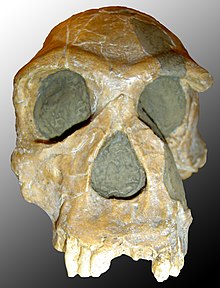Homo habilis
From Wikipedia, the free encyclopedia
| Homo habilis Temporal range: 2.3–1.4 Ma Pliocene-Pleistocene | |
|---|---|
 | |
| Scientific classification | |
| Kingdom: | Animalia |
| Phylum: | Chordata |
| Class: | Mammalia |
| Order: | Primates |
| Family: | Hominidae |
| Genus: | Homo |
| Species: | H. habilis |
| Binomial name | |
| †Homo habilis Leakey et al., 1964 | |
Homo habilis has often been thought to be the ancestor of the more gracile and sophisticated Homo ergaster, which in turn gave rise to the more human-appearing species, Homo erectus. Debates continue over whether H. habilis is a direct human ancestor, and whether all of the known fossils are properly attributed to the species. However, in 2007, new findings suggest that the two species coexisted and may be separate lineages from a common ancestor instead of H. erectus being descended from H. habilis.[4]
Contents[hide] |
Findings
One set of fossil remains (OH 62), discovered by Donald Johanson and Tim White in Olduvai Gorge in 1986, included the important upper and lower limbs.[5] Their finding stimulated some debate at the time.[6] An older (1963) finding from the Olduvai site found by N. Mbuika had included a lower jaw fragment, teeth and upper mandible possibly from a female dating 1.7 million years old. The remains from 3 skeletons stacked on top of each other[7] demonstrated australopithecine-like body with a more human-like face and smaller teeth. Compared to australopithecines, H. habilis's brain capacity of 363 and 600 cm³ was on average 50% larger than australopithecines, but considerably smaller than the 1350 to 1450 cm³ range of modern Homo sapiens. These hominins were smaller than modern humans, on average standing no more than 1.3 m (4 ft 3 in) tall.The small size and rather primitive attributes have led some experts (Richard Leakey among them) to propose excluding H. habilis from the genus Homo, and renaming as "Australopithecus habilis".
[edit] KNM ER 1813
KNM ER 1813 is a relatively complete cranium which dates 1.9 million years old, discovered at Koobi Fora, Kenya by Kamoya Kimeu in 1973. The brain capacity is 510 cm³, not as impressive as other early specimen and forms of Homo habilis discovered.OH 24 (AKA Twiggy) is a roughly deformed cranium dating 1.8 million years old discovered in October 1968 at Olduvai Gorge, Tanzania. The brain volume is just under 600 cm³; also a reduction in a protruding face is present compared to members of more primitive Australopithecines.
[edit] KNM ER 1805
KNM ER 1805 is a specimen of an adult H. habilis made of 3 pieces of cranium dating 1.74 million years old from Koobi Fora, Kenya. Previous assumptions were that this specimen belongs to H. erectus based on the degree of prognathism and overall cranial shape.[edit] Interpretations
Homo habilis is thought to have mastered the Olduwan era (Lower Paleolithic) tool case which utilized stone flakes. These stone flakes were more advanced than any tools previously used, and gave H. habilis the edge it needed to prosper in hostile environments previously too formidable for primates. Whether H. habilis was the first hominid to master stone tool technology remains controversial, as Australopithecus garhi, dated to 2.6 million years ago, has been found along with stone tool implements at least 100,000 - 200,000 years older than H. habilis.Most experts assume the intelligence and social organization of H. habilis were more sophisticated than typical australopithecines or chimpanzees. Yet despite tool usage, H. habilis was not the master hunter that its sister species (or descendants) proved to be, as there is ample fossil evidence that H. habilis was a staple in the diet of large predatory animals such as Dinofelis, a large scimitar-toothed predatory cat the size of a jaguar.[8] H. habilis used tools primarily for scavenging, such as cleaving meat off carrion, rather than defense or hunting. Homo habilis is thought to be the ancestor of the lankier and more sophisticated Homo ergaster, which in turn gave rise to the more human-appearing species Homo erectus. Debates continue over whether H. habilis is a direct human ancestor, and whether all of the known fossils are properly attributed to the species.
Homo habilis co-existed with other Homo-like bipedal primates, such as Paranthropus boisei, some of which prospered for many millennia. However, H. habilis, possibly because of its early tool innovation and a less specialized diet, became the precursor of an entire line of new species, whereas Paranthropus boisei and its robust relatives disappeared from the fossil record. Homo habilis may also have coexisted with Homo erectus in Africa for a period of 500,000 years.[9]



0 comments:
Post a Comment